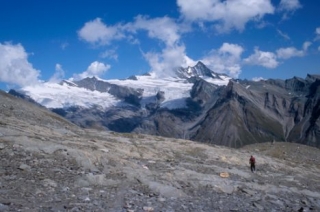If you enjoy ski touring, Austria is one of the most spectacular countries to explore, with hundreds of corners to discover and perfect for winter sports. We’ll show you some unforgettable spots to access and enjoy.
The Glockner massif includes Austria’s highest peak: the Grossglockner (3,797 m). The Venediger group features another of the highest peaks, the Gross Venediger (3,674 m), and is one of Austria’s most compelling massifs for ski mountaineering due to the ideal gradient of its slopes.

Although the route avoids glacier crevasses, they demand attention even in good weather. An intermediate ski mountaineer can complete the proposed route in three days, ascending the highest peak of the massif with a final descent of over 2,300 m in elevation, taking you from eternal snows to an Austrian valley. However, the variations to this itinerary are numerous, and exhausting all possibilities in the Hohe Tauern is nearly impossible. We recommend tackling these routes between March and April.
Starting point
Prägraten (roughly 1,500 km from the La Jonquera border). Prägraten can be reached via Innsbruck (through Switzerland) or Bolzano (Italy). The nearest airports are Innsbruck, Bolzano, or Salzburg.
First stage. Prägraten - Streden (1,403 m) - Essener Rostocker Hütte (2,208 m). Elevation gain: approx. 810 m.
From Prägraten, drive 4 km on a paved road to Streden, where you’ll ski up the Maurer Valley. At 1,552 m, you’ll find the lower station of the cable car, which supplies the mountain hut and often transports backpacks for overnight guests. Ascend the left orographic slope, keeping the ravine to your left until reaching the cable car’s terminus, where the hut is located.
Variant. The hut serves as a base for climbs to the nearby Rostock Eck (2,749 m) or the more distant Westl. or Ostl. Simony Spitze (both peaks at 3,488 m), or the Malham Spitze.

Second stage. Essener Rostocker Hütte (2,208 m) - Maurer Törl (3,108 m) - Kürsinger Hütte (2,562 m). Elevation gain: 1,070 m total (900 m to the pass plus 170 m to the hut).
From the hut, ascend along the valley floor opening northward to the Maurer Törl pass. Descend via the Obersulzbach Kees to 2,350 m, where the hut is visible, perched dominantly above the glacier ice.
To reach the hut, climb the SW slope near the summer trail or, if snow-free, ascend toward the Zwischensulzbachtörl to 2,550 m, then follow the moraine to a small col (2,620 m) before descending to the hut.
Variant. It would be a shame to pass so close to the Grosser Geiger (3,360 m) without summiting; consider leaving part of your backpack weight at 2,800 m. Another option is descending via the Grosser Geiger’s western col—a more technical section that may require a rope.
Third stage. Kürsinger Hütte (2,562 m) - Gross Venediger (3,674 m) - Hinterbichl (1,340 m). Elevation gain: 1,130 m (870 m excluding the Gross Venediger ascent).

From the hut, climb to 2,620 m (the small col from the second option in the previous stage) and traverse downward to reposition on the Obersulzbach Kees. From there, ascend the glacier to the Venedigerscharte (3,413 m), the col between the Klein (small) and Gross Venediger.
Next, follow the south face of the Gross Venediger’s east ridge, traversing to the large cross marking the summit—though during our ascent, snow accumulation left the cross below the true high point.
Descend toward the Defreggerhaus (2,962 m), continuing down the Dorfer stream past the Johannis Hütte (2,121 m) to Hinterbichl. Since a 2,300 m descent isn’t an everyday feat, consider pausing to savour it at either hut. Note: check opening times in advance!

Variants. Beyond the obvious option of ascending from the Venedigerscharte col to the Klein Venediger (a peak just 70 m shorter than the Aneto isn’t summited daily), the Defreggerhaus (Haus means "house" in German) is an excellent base for climbs to nearby peaks like the Hoher Zaun or Weiss Spitze.











